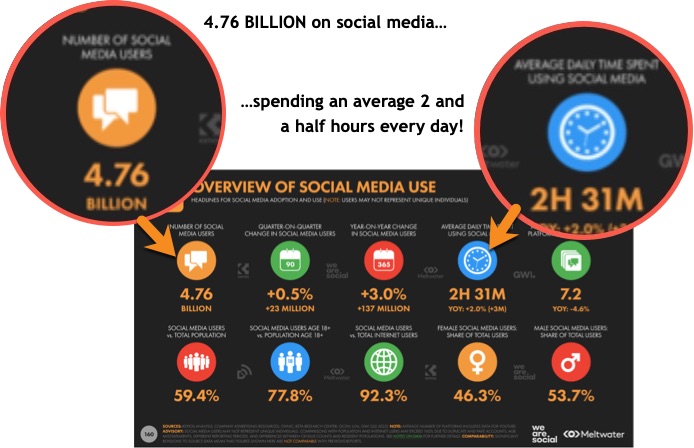Wondering how to get started with content repurposing?
This post is a comprehensive content repurposing guide that tells you everything you need to know, including:
- The benefits of repurposing content
- Where to start putting it into action
- Repurposing techniques to use when you're regularly publishing a blog, YouTube channel, or podcast
- The 3 best practices you need for effective content repurposing
- And more...
Let's dive straight in...
A Quick Introduction to Content Repurposing
Content repurposing means taking an existing piece of content and transforming it into a new piece of content, usually for a different platform or channel.
Blog posts for example can be quickly repurposed into brand new content such as:
- A series of posts on X…
- A video…
- An infographic…
- A rewritten version to publish on Medium or LinkedIn articles…
- And so on
But you don’t have to start with a blog post.
The same concept applies to practically any type of content.
But let’s be honest. The practice works best when you’re consistently repurposing long-form main "pillar” content that you publish regularly, such as on a blog or YouTube channel, or via a podcast.
That means you can develop a whole process or workflow that gets taken care of each time (preferably by other people) so that:
- Your content regularly shows up in front of new audiences on other channels, developing new relationships and gaining increasing traction over time (a.k.a. steadily improving results)…
- Your website benefits from the SEO advantages of growing audiences across multiple channels (a.k.a. higher rankings)…
- Your traffic increases across multiple sources, building immunity to changes to any particular channel (a.k.a. building resilience and financial security, rather than going out of business as a result of being suspended or banned on a particular platform, or because of sudden overnight algorithm changes, both factors that so many businesses are extremely vulnerable to)…
- You have a steadily growing web of content that spreads across the web, growing your online visibility and spreading the word about your business, each and every time you publish (a.k.a. you’re in front of customers everywhere)...
That all sounds nice, sure.
But it’s more than that.
In today’s digital landscape, it’s now downright essential.
Let's dig some more into why you should be repurposing content...
Why Repurpose Content?
In case you haven’t noticed, there’s more and more content everywhere…
Billions of people right across the planet are spending hours a day on social media and other content platforms, both consuming and creating content.

Increasing amounts of content are created by:
- Businesses keen to spread the word and attract customers to help sell their products and services…
- Bloggers, vloggers and other creators building audiences and monetizing traffic in a variety of ways…
- People simply communicating and interacting with each other on social media without any commercial intent.
Most content platforms now even pay people in different ways to create content.
Plus, you now have AI technologies like ChatGPT making content creation quicker and easier, with some businesses now churning out content in bulk via such services.
Reaching new audiences can be easy with content repurposing. Regularly repurpose your main "pillar" content into new formats suitable for publishing on other platforms.Click To Post OnThe amount of content in circulation is not just growing, but accelerating. So,,,
How does your business avoid losing audience (and attention) share, getting drowned out, and becoming irrelevant?
Is the only option paid advertising?
Paid ads should be part of the mix, sure. But there are problems with advertising too:
- What happens when the budget runs out?
- When rising ad costs make it too expensive?
- When you find your ad account shut down or suspended?
- When your audience is just blocking ads and turning off tracking in increasing numbers?
Ultimately, the best strategy for lead and customer acquisition uses a mixture of organic and paid.
With organic content marketing:
- The longer term payoff is much higher…
- Your business becomes far more resilient…
- Studies have found organic leads convert better and are more valuable—they arrive already ‘warm’ rather than feeling cold and defensive…
- You can’t turn the traffic off, even if you wanted to (I’m still getting traffic to sites I shut down years ago, thanks to previous organic marketing activities!)
By developing audiences interested in your content, paid ads can then be used to help push prospects through your conversion funnel.
But your sales won't rely completely on paid, which means you're a lot less vulnerable.
So,,,
How do you still win organically, despite increasing content saturation?
The answer lies with content repurposing.
A few businesses tinker with it, fiddle around the edges with something repurposed here, something else over there. All very sporadic and not particularly strategic.
Very few businesses approach it strategically in a way that means they’re publishing regularly and consistently across multiple channels, steadily building audiences on each, and cross-promoting their content to lift all of it higher.
But in doing so, you leverage your content in a highly efficient and effective way that helps you rise above everything else.
Don't just tinker with content repurposing. Doing it sporadically is inefficient and ineffective. Do it regularly and consistently to grow audiences on different platforms.Click To Post OnYou start enjoying multiple touchpoints with prospects who see you on multiple platforms, and afford you higher authority and credibility as a result.
You’re no longer in the danger zone of reliance on one specific platform or traffic source.
Content on one platform helps increase visibility of content elsewhere, such as:
- Embedded videos in blog posts lifting both the videos on YouTube and the blog posts on search engines…
- Cross linking between your content on different platforms, increasing direct traffic and helping with SEO…
- Growing audiences on social channels again helping with search visibility of your content and providing direct traffic…
- Increasing levels of authority that help attract new opportunities to share your content, spread the word about your business and attract new customers.
And it’s far quicker and easier to repurpose some content you’ve already got (including delegating the job to someone else), than to create everything starting from scratch.
Where Do You Start With Repurposing Content?
The traditional advice is to start by identifying content that can be repurposed. For example, look for a blog post that did particularly well, and repurpose that.
Rubbish.
That type of advice is exactly what leads to sporadic once-in-a-while repurposing that has little to no benefit whatsoever.
It just doesn’t work.
For content to be effective on any platform, you need to turn up regularly and consistently on that platform.
That’s what builds up your audience, and your audience is what ultimately leads to success. That just doesn’t happen when you’re sporadic.
To succeed with content repurposing, you need to:
- Define a process to repurpose your main "pillar” content that works for your business (it can be really simple to start with—don’t try and do everything at once!)…
- Systemize it so it’s taken care of each and every time…
- Grow and improve your process and system over time, so you’re steadily covering more channels in a regular, consistent way where your customers congregate.
Doing otherwise is, quite frankly, a complete waste of time.
So… here’s how to approach it (these 7 key principles for developing an effective content repurposing workflow are covered in more detail here):
- As already stated, the most important thing is consistency…
- Just do something—it doesn’t have to be perfect, but just start somewhere…
- Create a written process so it can be improved and refined over time…
- To ensure regular and consistent action, delegate it…
- In time, add additional repurposing activities to reach more customers in more channels…
- Improve efficiency by leveraging your repurposed content wherever possible—in other words, once repurposed, use it for different purposes…
- Use software to help—automate the process as much as possible so it just gets done. Trafficonomy is designed for just that purpose, enabling you to create multi-channel content via a highly efficient workflow.
Don’t forget to check out our full guide on creating an effective content repurposing workflow.
Repurposing Techniques for Different Pillar Content
Here are just some ways in which your main "pillar” content (in other words, long form content you’re already publishing on a regular and consistent basis) can be repurposed, depending on whether it’s a blog, YouTube channel or podcast:
Blog
Regularly and consistently repurpose blog posts as follows:
- As part of a regular email newsletter…
- Within social media posts—think about quote images, X threads, carousel posts, and videos that can also be published on…
- YouTube—transform posts into videos on a YouTube channel (here’s how to set one up). Embed each video back into the original post…
- Medium Story—rewrite the original post (try using AI to help) so your blog maintains its uniqueness and so you multiply your search engine visibility…
- If you’re B2B, publish the same rewritten content as a LinkedIn article…
Check out this quick video for some more ideas to repurpose your blog content, or see the full guide:
YouTube Channel
Regularly and consistently repurpose YouTube videos as follows:
- Cut longer videos up into a handful of short engaging clips that can be uploaded and shared to social media platforms…
- Repurpose the transcription of a video into a written article that can be used as a blog post, embedding the video into it…
- Consider doing something similar via a Medium story and, for B2B businesses, a LinkedIn article…
- Look for suitable questions on Quora that your video helps with—add an answer based on your video’s content, and embed the video to provide more value, while growing subscribers and views…
- Promote your latest video by including it in a regular email newsletter…
There are some more ways to repurpose YouTube videos for different channels in the following video, or see the full guide here:
Podcast
Regularly and consistently repurpose podcast episodes as follows (if using video, see above too):
- Create a blog post that summarizes the content or uses some of the main takeaways. Embed the episode back into the post so people can listen…
- Similarly, create an article that can be shared as a Medium story or, for B2B audiences, a LinkedIn article…
- Create a regular email newsletter that helps promote your latest episode…
- Create text motion videos using some pertinent clips from each episode for sharing on social media…
- Take one or two main takeaways from each episode, and create carousel posts for sharing on social, or Pinterest Idea Pins…
For more ideas on content repurposing:
- Here’s a list of 25 top places where you can publish content and help spread the word about your business…
- Here are 21 ways to repurpose content for social media…
- Check out this list with over 70 different ways to repurpose content!
3 Best Practices for Repurposing Content the Right Way
Let’s sum up this content repurposing guide with the following 3 best practices:
1. Avoid One-Off Content Repurposing Activities
Repurposing content into a particular format just once, or otherwise sporadically, doesn’t afford the opportunity to become really good at it over time.
In addition, content marketing is only effective when you’re publishing content to a particular channel regularly and consistently.
So rather than one-off repurposing activities…
Avoid one-off content repurposing activities. Instead, systematically repurpose content each time you publish on your main "pillar" channel and grow audiences across multiple platformsClick To Post On2. Repurpose Content in Specific Ways, Each and Every Time
Look for opportunities to create systems and processes in your business for repurposing content on a regular and consistent basis onto different channels.
In other words, whatever your main "pillar” content channel might be (such as a blog, YouTube channel or podcast), you should know that each and every time you publish something, it’s going to be repurposed in specific ways to reach new audiences that wouldn’t otherwise know anything about you.
Use Trafficonomy to save hours of time and make it as efficient and streamlined as possible so it “just happens”..
3. Constantly Be Alert for Ways to Improve
Once you’re repurposing regularly and consistently, you’ll start to spot things that work well or not so well.
You’ll also start seeing things other people are doing that appear to be a potential improvement on your own approach.
You can then adjust your process—your system—accordingly, steadily improving and gaining mastery over particular channels over time.
In other words, it doesn’t matter that the way you repurpose content to start with isn’t perfect. In the beginning, it won’t be and that’s just fine.
What matters is that:
- You’re showing up regularly and consistently regardless…
- The steady and continuous improvements you make over time means your system becomes a significant asset to your business, potentially putting you in a leadership position within your market because you’re in front of customers everywhere and competitors simply can’t keep up.
Frequently Asked Questions
What is content repurposing?
Content repurposing involves transforming existing content, like blog posts, into new formats for different platforms.
Why should I repurpose content?
Repurposing content helps reach new audiences, improve SEO, increase traffic sources, and build resilience against platform changes.
How can I win organically with content repurposing?
Win organically by strategically repurposing content regularly across multiple channels to grow audiences and increase visibility.
Where do I start with content repurposing?
Start by developing a consistent process to repurpose main content, steadily expanding to cover multiple channels over time.
What are the best practices for effective content repurposing?
Avoid sporadic repurposing, consistently repurpose content onto different platforms, and continuously improve your repurposing process over time.
To Conclude
With content repurposing now an essential part of gaining visibility, attracting customers and growing your business, it’s important to approach it in the right way.
Approaching it sporadically or as an optional occasional addition to your normal content publishing process no longer cuts it and is essentially a waste of time.
Instead, you need a process or system through which, each and every time you publish content to your main "pillar” content channel, it also gets repurposed into different formats to facilitate regular and consistent publication across multiple channels, helping you reach new audiences, with the content cross-promoted to lift all of it higher.
By leveraging content in this way, businesses not only enjoy multiple touchpoints with prospects who see them on multiple platforms, they also become more resilient and less reliant on any one particular platform or source of traffic. All big wins in my book!



